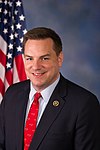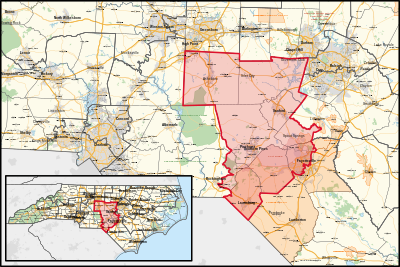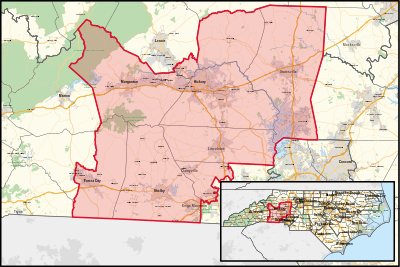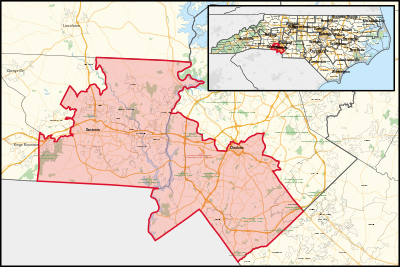Hunt v. Cromartie, 526 U.S. 541 (1999), was a United States Supreme Court case regarding North Carolina's 12th congressional district. In an earlier case, Shaw v. Reno, 509 U.S. 630 (1993), the Supreme Court ruled that the 12th district of North Carolina as drawn was unconstitutional because it was created for the purpose of placing African Americans in one district, thereby constituting illegal racial gerrymandering. The Court ordered the state of North Carolina to redraw the boundaries of the district.

Ohio is divided into 15 congressional districts, each represented by a member of the United States House of Representatives. After the 2010 census, Ohio lost two House seats due to slow population growth compared to the national average, and a new map was signed into law on September 26, 2011. Starting in the 2022 midterms, per the 2020 United States census, Ohio will lose a congressional seat.
Ohio's 3rd congressional district is located entirely in Franklin County and includes most of the city of Columbus. The current district lines were drawn in 2022, following the redistricting based on the 2020 census. It is currently represented by Democrat Joyce Beatty.

Shaw v. Reno, 509 U.S. 630 (1993), was a landmark United States Supreme Court case in the area of redistricting and racial gerrymandering. After the 1990 census, North Carolina qualified to have a 12th district and drew it in a distinct snake-like manner in order to create a "majority-minority" Black district. From there, Ruth O. Shaw sued to challenge this proposed plan with the argument that this 12th district was unconstitutional and violated the Fourteenth Amendment under the clause of equal protection. In contrast, Reno, the Attorney General, argued that the district would allow for minority groups to have a voice in elections. In the decision, the court ruled in a 5–4 majority that redistricting based on race must be held to a standard of strict scrutiny under the equal protection clause and on the basis that it violated the Fourteenth Amendment because it was drawn solely based on race.

After the 2000 census, the Commonwealth of Pennsylvania was divided into 19 congressional districts, decreasing from 21 due to reapportionment.

Florida is divided into 28 congressional districts, each represented by a member of the United States House of Representatives. After the 2020 census, the number of Florida's seats was increased from 27 to 28, due to the state's increase in population, and subsequent reapportionment in 2022.

North Carolina's 1st congressional district is located in the northeastern part of the state. It consists of many Black Belt counties that border Virginia and it extends southward into several counties of the Inner Banks and the Research Triangle. It covers many rural areas of northeastern North Carolina, among the state's most economically poor, as well as outer exurbs of urbanized Research Triangle. It contains towns and cities such as Greenville, Rocky Mount, Wilson, Goldsboro, Henderson, and Roanoke Rapids.

North Carolina's 12th congressional district is a congressional district located in the northern and eastern portions of Charlotte as well as surrounding areas in Mecklenburg County and Cabarrus County represented by Democrat Alma Adams. Prior to the 2016 elections, it was a gerrymandered district located in central North Carolina that comprised portions of Charlotte, Winston-Salem, Greensboro, Lexington, Salisbury, Concord, and High Point.
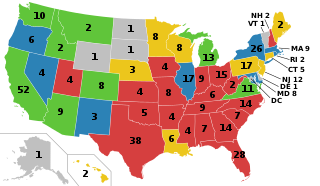
Gerrymandering is the practice of setting boundaries of electoral districts to favor specific political interests within legislative bodies, often resulting in districts with convoluted, winding boundaries rather than compact areas. The term "gerrymandering" was coined after a review of Massachusetts's redistricting maps of 1812 set by Governor Elbridge Gerry noted that one of the districts looked like a mythical salamander.
The National Democratic Redistricting Committee (NDRC) is a US political organization that focuses on redistricting and is aligned with the Democratic Party. It was founded in 2017 with the primary goal of stopping partisan gerrymandering and advocating for fair and transparent redistricting processes. The organization coordinates campaign strategy, supports redistricting reform, and files lawsuits against state redistricting maps.

The 2020 United States redistricting cycle is in progress following the completion of the 2020 United States census. In all fifty states, various bodies are re-drawing state legislative districts. States that are apportioned more than one seat in the United States House of Representatives are also drawing new districts for that legislative body.
Cooper v. Harris, 581 U.S. ___ (2017), is a landmark decision by the Supreme Court of the United States in which the Court ruled 5–3 that the North Carolina General Assembly used race too heavily in re-drawing two Congressional districts following the 2010 Census.
REDMAP is a project of the Republican State Leadership Committee of the United States to increase Republican control of congressional seats as well as state legislatures, largely through determination of electoral district boundaries. The project has made effective use of partisan gerrymandering, by relying on previously unavailable mapping software such as Maptitude to improve the precision with which district lines are strategically drawn. The strategy was focused on swing blue states like Pennsylvania, Ohio, Michigan, North Carolina, and Wisconsin where there was a Democratic majority but which they could swing towards Republican with appropriate redistricting. The project was launched in 2010 and estimated to have cost the Republican party around US$30 million.
Benisek v. Lamone, 585 U.S. ____ (2018), and Lamone v. Benisek, 588 U.S. ____ (2019), were a pair of decisions by the Supreme Court of the United States in a case dealing with the topic of partisan gerrymandering arising from the 2011 Democratic party-favored redistricting of Maryland. At the center of the cases was Maryland's 6th district which historically favored Republicans and which was redrawn in 2011 to shift the political majority to become Democratic via vote dilution. Affected voters filed suit, stating that the redistricting violated their right of representation under Article One, Section Two of the U.S. Constitution and freedom of association of the First Amendment.
Rucho v. Common Cause, No. 18-422, 588 U.S. 684 (2019) is a landmark case of the United States Supreme Court concerning partisan gerrymandering. The Court ruled that while partisan gerrymandering may be "incompatible with democratic principles", the federal courts cannot review such allegations, as they present nonjusticiable political questions outside the jurisdiction of these courts.
Thomas Brooks Hofeller was a Republican political strategist primarily known for his involvement in gerrymandering electoral district maps favorable for Republicans. David Daley of The New Yorker referred to Hofeller as "the master of the modern gerrymander." According to The New York Times, Hofeller's "mastery of redistricting strategy helped propel the Republican Party from underdog to the dominant force in state legislatures and the United States House of Representatives."

Redistricting in North Carolina has been a controversial topic due to allegations and admissions of gerrymandering.
Moore v. Harper, 600 U.S. 1 (2023), is a decision of the Supreme Court of the United States that rejected the independent state legislature theory (ISL), a theory that asserts state legislatures have sole authority to establish election laws for federal elections within their respective states without judicial review by state courts, without presentment to state governors, and without constraint by state constitutions. The case arose from the redistricting of North Carolina's districts by its legislature after the 2020 United States census, which the state courts found to be too artificial and partisan, and an extreme case of gerrymandering in favor of the Republican Party.

The 2024 United States House of Representatives elections will be held on November 5, 2024, as part of the 2024 United States elections, to elect representatives from all 435 congressional districts across each of the 50 U.S. states, as well as six non-voting delegates from the District of Columbia and the inhabited U.S. territories. Special elections may also be held on various dates throughout 2024. Numerous other federal, state, and local elections, including the U.S. presidential election and elections to the Senate, will also be held on this date. The winners of this election will serve in the 119th United States Congress, with seats apportioned among the states based on the 2020 United States census.
Alexander v. South Carolina State Conference of the NAACP is a pending United States Supreme Court case regarding racial gerrymandering and partisan gerrymandering. It's the first partisan gerrymandering case taken by the Supreme Court after its landmark decision in Rucho v. Common Cause which stated that partisan gerrymandering claims present political questions beyond the reach of the federal courts, and the first racial gerrymandering case after the court's landmark decision in Allen v. Milligan.


















